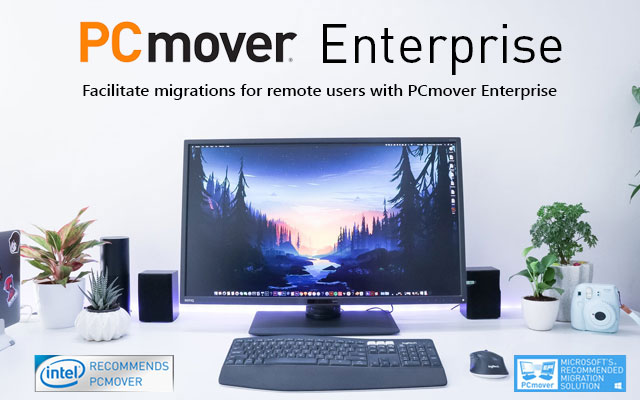Try PCmover
Please note the Evaluation copy of PCmover Enterprise requires you to be logged into a domain when testing. If you would like to test Enterprise without this requirement, please contact corpsales@laplink.com to receive an alternate copy of the software.
Thank you for your interest, and for choosing Laplink Software!
Contact Sales

How to Facilitate a Remote User Migration
Deploying a new PC for a remote or home office user is always a challenge, particularly in IT environments that aren’t heavily managed. The question becomes, “what is the easiest way to configure the new PC to look and act just like the old PC?” Manually copying information and installing applications nearly always results in follow-up Service Desk; the user doesn’t have all their applications, or can’t find where certain data ended up. With the recent dramatic increase in remote work (likely including some, or all, of your IT staff), scaling this type of manual migration effort is nearly impossible. Enter, the need for a remote user migration solution.
Today, we have a guest post from our very own Tom Coyle, Senior Enterprise Solution Architect, & Tim Worcester, Director of Customer Experience!
PCmover, the only migration solution recommended by Microsoft and Intel, makes this task easy. With a PCmover migration, the new PC will work and feel just like the old PC, including all user data, profile, and application settings – and even the applications themselves. PCmover, by default, running as a completely “vanilla” configuration, will automatically locate and transfer the applications and all user data to a new environment. With some simple planning and minimal configuration, your users can even drive their own migrations. This dramatically reduces the need to engage IT resources.
This guide gives a brief overview of how PCmover can help you perform a flawless remote user migration quickly and easily. PCmover is extremely flexible and can accommodate nearly any real-world use case. Here, we offer three common scenarios as examples. For help with your specific use case, contact Laplink for a one-on-one discussion, demonstration, or a trial license.
Examples of Common Scenarios
1) Migration for minimally-managed remote office PCs
The most problematic manual-migration scenario is often the smallest. When users purchase and configure their own PCs, without central imaging and deployment, the base configuration is unknown. When users have full control over their own machines, without central IT management, there is no knowledge about what applications may be installed, what profile settings are configured, and where user data is located.
This scenario is identical to that of any non-business home user who needs to migrate to a new PC. The consumer-centric editions of PCmover have been used successfully by millions of regular home consumers to migrate to a new PC and, here, we will build on that success by introducing PCmover Policies to control precisely how PCmover works in order to standardize migrations and minimize the choices that the user will need to make (and thus possibility for human error).
Company1 is a small business without IT Asset Management capability. There is no on-premise Active Directory domain or cloud-based Azure Active Directory architecture. All PCs are workgroup-based and managed entirely by the users themselves, who have local administrator access.
- When a user needs a new PC, they are instructed to order any Windows 10 PC from any supplier.
- PCmover is pre-configured with a PCmover Policy, defined by IT, to make certain key choices automatically, and hide other options (e.g. to limit the ability to select connection type) while leaving certain other available options for the user (e.g. application selection).
- PCmover is portable. You do not need to install the software on the machines involved in a transfer. This PCmover-plus-Policy configuration is posted as a ZIP archive, in a secure location, on a company website that is accessible to the users.
- The user is provided instructions to download, extract, and run PCmover on both machines to perform the direct transfer over the user’s home LAN or WiFi connection. When transfer is complete, the user will be able to login and immediately resume working in an environment identical to the old PC.
2) Migration for PCs that are imaged and shipped to the user, from a central deployment facility
Company2 is a large corporation sending new laptops to their users who must work from home. The company’s stock of new machines is in a central deployment facility, and the in-house Deployment Team configures each new PC with a company-approved Windows 10 image, prior to shipment to the user. The image includes PCmover preinstalled.
- PCmover is pre-configured with a PCmover Policy as described in Example 1.
- Not all the new PCs have Ethernet ports available for a direct transfer connection, but all new and old PCs are known to have USB 3.0 ports available. So, each new PC shipment is bundled with a Laplink USB 3.0 direct transfer cable. This direct USB connection can also significantly increase transfer throughput versus that of Ethernet or WiFi.
- To make PCmover available to the old PC, a deployment package is posted on a secure company support or collaboration site (e.g. OneDrive). As noted in Example 1, PCmover is portable, so this package could simply be a ZIP of the PCmover executable folder that also includes the IT-defined Policy, rather than needing to create some sort of Win32 or MSI deployment package.
- A one-page “how to” document is sent to the user, instructing the user how to download PCmover to the old PC, extract the archive, launch PCmover on both PCs, properly connect the cable, and make any required or optional transfer choices.
- The new PC is shipped to the user, who follows the instructions. When transfer is complete, the user will be able to login and immediately resume working in an environment identical to the old PC.
- Finally, the new PC shipment includes a prepaid shipping label to return the old PC back to the Deployment Team for recycling, along with the USB cable to be used in another remote user migration.
Variations on this method may include:
-
- When Ethernet or Thunderbolt ports are known to be available on both the old and new PCs, these cables may be used as an alternative to the Laplink USB cable.
- IT-driven remote user migration: For “white glove” or technically unsophisticated users where IT Remote Control is available, the user will simply connect the old and new PCs to their home internet connection and connect the PCs with the direct cable. IT will take control of the machines and perform the migration for the user.
3) Migration for PCs managed by Windows Autopilot and Intune
Large organizations with diverse groups of remote users are beginning to move to Microsoft’s modern deployment and management process and tools. If you are already using Autopilot and Intune, PCmover can integrate easily into your deployment process.
Company3 is using Azure Active Directory, Windows Autopilot, and Intune to deploy and manage new PCs for remote users.
- The user is instructed to purchase and expense a new off-the-shelf Windows 10 PC from any supplier. The user connects the new PC to the home network and logs in with the Azure Active Directory User Account.
- Windows Autopilot automatically enrolls the device in Intune and applies the company policy configuration.
- PCmover, with an appropriate PCmover Policy (as described in Example 1), is bundled for Intune as a Win32 deployment package, and is designated as a “Required” application for both the old and new PCs. When the deployment completes, a PCmover icon will appear automatically on the user’s desktop, along with a document providing instructions for use.
- The user runs PCmover on each PC and perform a direct transfer over the home network.
Other Use Cases?
For other specific use cases you may have, you can contact us for a one-on-one discussion, demonstration, and a trial license. You can also watch the webinar demo HERE.
Neil Minetto

Neil is the Senior Director of Inside Sales & Marketing at Laplink, bringing deep expertise in pay-per-click advertising, email marketing, lead nurturing, marketing automation, and digital strategy. His career journey includes leadership roles at Indigo Slate, Oracle, and Zones. Neil earned his BA in Communications, Advertising, and Business from BYU. Outside of work, he’s a golf fanatic (which is an understatement) and loves discovering new places with his wife. Whether it's refining marketing strategies or perfecting his golf swing, Neil is always looking for ways to get better.
Read more about Neil Minetto...

Add Comment